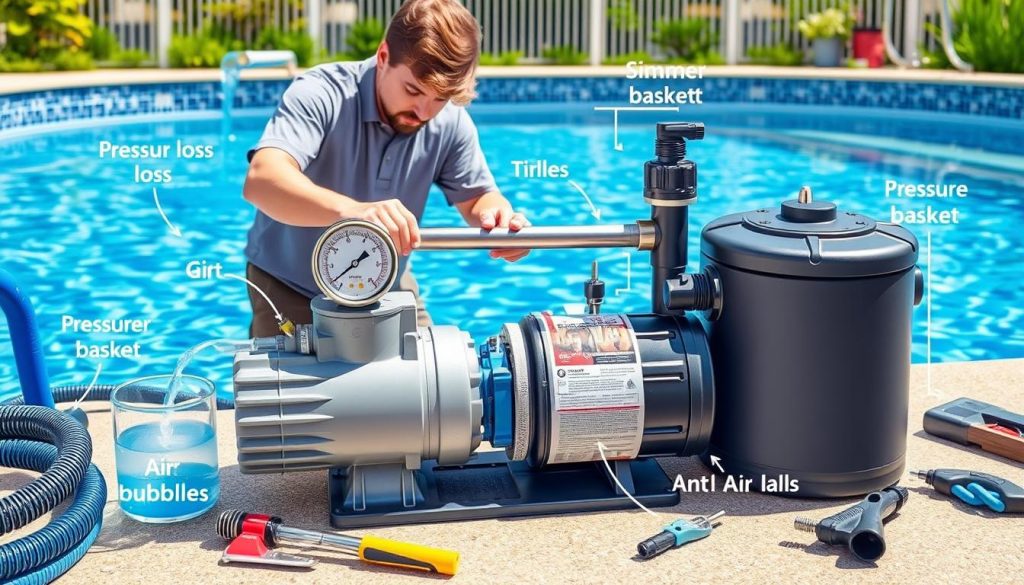
Pool pump pressure loss can ruin your summer fun. You’re ready to dive in, but find stagnant, murky water instead. Your pump struggles to circulate water, causing poor filtration and an uninviting pool.
This common issue has many possible causes. Blocked baskets, low water levels, and dirty filters can all be culprits. Improper pump priming, clogged impellers, and plumbing leaks may also be to blame.
Air leaks on the suction side or faulty valves can reduce water flow too. These problems lead to ineffective filtration and decreased pool performance.
Debris-filled baskets are a frequent cause of low or no flow. Hot weather can lower water levels, affecting pump pressure. Losing over ½” of water daily might indicate a leak.
To fix pressure loss, check each component systematically. Address any underlying issues you find. Regular maintenance and troubleshooting will keep your pool circulating smoothly.
With proper care, you can restore optimal water flow. Your pool will remain a pristine oasis for family enjoyment all summer long.
Common Causes of Pool Pump Pressure Loss
Pool pump pressure loss can hurt water circulation and filtration. Let’s explore the main causes and solutions to keep your pool running smoothly.
Blocked Baskets and Skimmer
Clogged baskets and skimmers often cause pool pump pressure loss. Debris piles up in the pool skimmer basket and pump basket, blocking water flow.
This debris buildup strains the pump, risking damage or failure. Check and empty both baskets weekly to maintain proper circulation.
Clean baskets more often if your pool is near trees or heavily used. This simple task can extend your pool pump’s life.
Low Water Level in the Pool
A low pool water level can cause pump pressure loss. Air enters the system when water drops below the skimmer opening.
This air can make the pump lose prime and reduce pressure. Evaporation, splashing, or leaks can lower water levels.
Keep water at the middle of the skimmer opening. Check for leaks if you lose more than 1/4 inch daily.
According to industry experts, a pool can lose up to 1/4 inch of water per day due to evaporation, and in some cases, evaporative losses can be as high as 1/2 inch daily, depending on factors such as wind, temperature, and humidity levels.
Dirty or Clogged Filter
A dirty pool filter restricts water flow, causing pressure loss. It forces the pump to work harder, risking damage.
Regular pool filter maintenance prevents this issue. Clean or backwash your filter based on the manufacturer’s guidelines.
A clean filter ensures optimal water flow and protects your pump from strain.
| Type of Filter | Cleaning Frequency | Cleaning Method |
|---|---|---|
| Sand Filter | Every 1-2 weeks | Backwash and rinse |
| Cartridge Filter | Every 2-4 weeks | Remove and hose down cartridge |
| Diatomaceous Earth (DE) Filter | Every 1-2 months | Backwash and recharge with DE powder |
Diagnosing Pool Pump Pressure Issues
Pool pump pressure loss can be frustrating. To fix it, we must find the cause. We’ll explore two key aspects: proper pump priming and inspecting the pump impeller.

Check for Proper Pump Priming
Improper pump priming often causes pressure loss. Priming fills the pump basket with water. This ensures efficient operation and prevents air locks.
Air locks disrupt water flow and decrease pressure. To prime the pump, follow these steps:
- Turn off the power to the pump.
- Remove the pump lid and fill the pump basket with water.
- Ensure the o-ring is lubricated and the lid is securely replaced.
- Turn the pump back on and allow it to run for a few minutes to establish proper water flow.
If problems persist, check for leaks or a faulty check valve. These issues can cause ongoing priming problems.
Inspect the Pump Impeller
The pump impeller is crucial for water circulation. It draws water into the pump and pushes it through filtration. Debris can block the impeller, reducing water flow.
To inspect the pump impeller:
- Turn off the power to the pump and close any valves on the suction and discharge sides of the pump.
- Remove the pump housing to access the impeller.
- Check for any visible debris, such as leaves, twigs, or small objects, and carefully remove them.
- Examine the impeller for signs of wear, damage, or corrosion. If the impeller is severely damaged, it may need to be replaced.
- Reassemble the pump housing and ensure all connections are secure before turning the power back on.
Regular impeller cleaning prevents blockages. It maintains optimal water flow and reduces pressure loss risks. This also helps avoid other pump-related problems.
Proper pump priming and a clean, functional impeller are essential for maintaining consistent water pressure and ensuring the longevity of our pool pump.
Fixing Pool Pump Pressure Loss
Check for leaks in your pool’s plumbing system to troubleshoot pump pressure loss. Look for wet spots, puddles, or soft ground around pipes and fittings. These signs can indicate a leak.
Leaks in the Plumbing System
Suction side leaks can let air enter the system, reducing water flow and pressure. Pressure side leaks may cause water loss and decrease pump efficiency. Address leaks quickly to restore proper pressure.
Air Leaks in the Suction Side
Air leaks in the suction side can cause pressure loss. Check the pump basket lid, unions, and threaded connections. Look for bubbles in the pump basket or listen for sucking sounds.
Tighten connections, replace worn gaskets, or apply silicone sealant to fix these issues. These steps can often resolve air leaks and improve pump performance.
Malfunctioning Valves or Actuators
Valve and actuator problems can affect pool pump pressure. Incorrect multiport valve position or faulty actuators may restrict water flow. Inspect valves and actuators regularly for proper operation.
Replace faulty components if needed. Addressing these issues ensures your pool pump works efficiently. This helps maintain a clean and healthy swimming environment.







